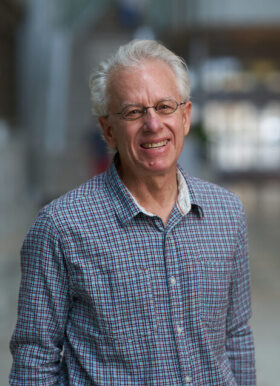
Publications in Pubmed | ResearchGate Profile
Research
The Bridgman laboratory focuses on the basic cellular properties of developing nerve and muscle with emphasis on relating structure to function. Several different projects are currently underway. The first involves the mechanism of nerve growth cone locomotion and the relationship between growth cone motility, guidance and nerve outgrowth. The focus of this work is on the mechanoenzymes and cytoskeletal components that are likely to participate in growth cone motility. Cellular and molecular methods are being used to locate and disrupt the activity of mechanoenzymes and cytoskeletal polymers, such as actin filaments and microtubules thought to be important for locomotion.
The second projects focuses on developing new techniques to guide growing neurons in cell culture. The lab has developed a new method of forming substrate patterns that can be produced after cells have been plated. This allows the change the of the direction of growth interactively and form simple neuronal circuits.
Selected publications
- Turney SG, Chandrasekar I, Ahmed M, Rioux RM, Whitesides GM, Bridgman PC. Variation and selection in axon navigation through microtubule-dependent stepwise growth cone advance. bioRxiv. 2020; doi: 10.1101/2020.01.29.925602.
- Bridgman PC. Using rotary shadow electron microscopy to characterize semaphorin-mediated growth cone collapse. Methods in Molecular Biology. 2017; 1493:185-194.
- Chandrasekar I, Goeckeler ZM, Turney SG, Wang P, Robert B. Wysolmerski RB, Adelstein RS, Bridgman PC. Nonmuscle myosin II is a critical regulator of clathrin mediated endocytosis. Traffic. 2014; 15:418-32. doi: 10.1111/tra.12152. Epub Feb 12, 2014.
- Chandrasekar I, Huettner JE, Turney SG, Bridgman PC. Myosin II regulates activity dependent compensatory endocytosis at central synapses. J Neurosci. Oct 9, 2013; 33:16131-45.
- Bridgman PC. Myosin motor proteins in the cell biology of axons and other neuronal components. Results Probl Cell Diff. 2009; 48:91-105.
- Brown JA, Bridgman PC. Disruption of the cytoskeleton during Semaphorin 3A induced growth cone collapse correlates with differences in actin organization and associated binding proteins. Dev Neurobiol. 2009; 69:633-646.
- Brown JA, Wysolmerski RB, Bridgman PC. Dorsal root ganglion neurons react to semaphorin 3A application through a biphasic response that requires mutilple myosin II isoforms. Mol Biol Cell. 2009; 20:1167-1179.
- Turney SG, Bridgman PC. Laminin stimulates and guides axonal outgrowth via growth cone myosin II. Nature Neurosci. 2015; 8:717-719.
- Brown ME, Bridgman PC. Retrograde flow rate is increased in growth cones from myosin IIB knockout mice. J Cell Sci. 2003; 116:1087-1094.
- Bridgman PC. Growth cones contain myosin II bipolar filament arrays. Cell Motil and Cytoskel. 2002; 52:91-96.
- Bridgman PC, Dave S, Asnes CF, Tullio AN, Adelstein RS. Myosin IIB is required for growth cone motility. J Neurosci. 2001; 21:6159-69.
See a complete list of Dr. Bridgman’s publications on PubMed.
Education
1974 BA, University of California, San Diego
1974 MS, University of California, San Diego
1980 PhD, Purdue University, Lafayette, IN